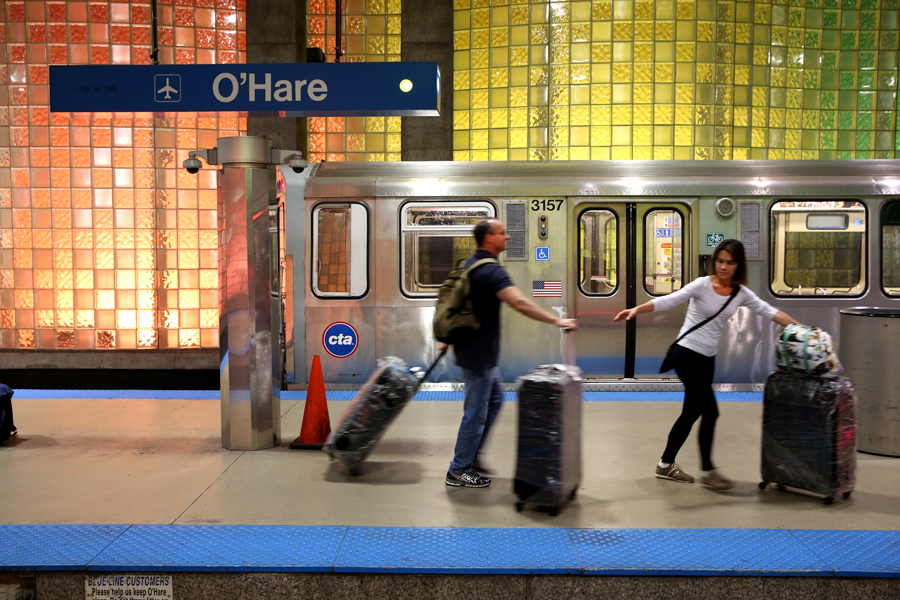A week ago the Tribune reported that the Emanuel administration is taking preliminary steps toward building an express train to O'Hare Airport, an idea first floated by then-Mayor Richard M. Daley more than 20 years ago. In theory such a train would speed travel time to downtown in exchange for premium prices—probably $30 to $35 per ride, according to the Tribune.
The city is hiring an engineering firm to spend nearly a year studying the project, but in the spirit of civic generosity, I am sharing my findings right now for free: this is a terrible idea.
Here are four reasons.
1. Toronto is a failure.
Chicago officials cite Toronto’s airport express as a model—but no one is riding it. In 2015, Toronto officials declared that the Union Pearson Express would be considered a success if it carried 5,000 riders a day within its first year. That's a pretty low bar for a train line in a major city—by comparison, Chicago’s No. 9 Ashland bus carries just under 30,000 a day—but even so, Toronto’s express has fallen woefully short, averaging just 2,186 riders per day in November, a decrease from the month before.
And there's good reason to believe that an O'Hare express train would perform even worse. Because Toronto's subway doesn't reach the airport, its express train is more than twice as fast as the next best transit option, saving passengers more than half an hour to downtown. By contrast, an O'Hare express would save, at best, about 10 to 15 minutes.
2. The Blue Line works great, thank you very much.
We already have one of North America’s best transit connections to an airport. Thanks to the CTA's Your New Blue rehabilitation program, travel times from O'Hare to the Loop are down to 37 minutes, and further work could push that down to 35. Even before that, an analysis from FiveThirtyEight found Chicago was one of just three cities in the country where you could get from the airport to downtown faster on public transit than by driving. And while some people gripe about the Blue Line's old train cars, the CTA is already working on ordering new cars that could be designed with airport-friendly features like luggage racks.
3. It might not even save much time.
Studies suggest that an O'Hare express could reach Union Station in 20 to 25 minutes—10 to 15 minutes faster than a well-maintained Blue Line. But that's just travel time. Let’s not forget the time waiting for a train. When you show up to the O'Hare Blue Line station, you can be pretty certain that your journey will begin soon: a train leaves O'Hare every 4 to 10 minutes all day. An airport express train, on the other hand, would be likely to leave less frequently—probably the same 15-minute interval of other cities, including London and Toronto.
Imagine your plane arrives at O'Hare around rush hour. If you take the Blue Line, you could be downtown in at most 40 minutes—35 minutes of travel (once Your New Blue is done) plus a four-minute wait. If you pay a premium for the express, you still might not be downtown for 40 minutes, given 25 minutes of travel plus as much as a 15-minute wait.
And your total travel could be even worse, depending on where you're going. If like many visitors your hotel is near Millennium Park or Michigan Avenue, the Blue Line will drop you off under Dearborn Street, a five-minute walk away. The express will probably drop you off at Union Station—where you can either walk for 20 minutes, wait for a bus, or hail a cab.
4. It's too expensive.
Even if it could save passengers time, building an O'Hare express train would be the transit equivalent of buying a second flat-screen TV instead of fixing the gaping hole in your roof. Chicago’s list of transit needs is long; the money available to address them is small. Many neighborhoods' only transit options are buses whose frequency, speed, and reliability need to be improved, and too much of the el system is still mired in slow zones because of deferred maintenance.
The region's transportation system needs $19 billion just to get to a state of good repair, according to the Regional Transportation Authority. It is hard to imagine a less pressing use for a billion dollars than providing a second O'Hare rail connection for the benefit of the few travelers who are willing to spend an extra $30—to save possibly no time. And while city officials are promising to attract money from private investors, it's unclear who would be interested in such a deal. Remember how Toronto's express train barely gets 2,000 rides a day? Well, it needs at least 7,000 to break even on its operating expenses—let alone begin to pay off its construction costs or turn a profit.
The bright side, I suppose, is that the O'Hare express proposal might get Chicago talking about big transportation projects again.
And there are plenty of progressive, transformational ideas out there. There's the Metropolitan Planning Council's 2011 study on a network of light rail-like bus lines that would revolutionize transit access for those who don't current live near an el station, or whose trips don't involve traveling to and from the Loop. Or if we're looking to Toronto for public transit inspiration, we could ape its plan to turn its commuter rail network into a true regional rail system. Soon, GO trains—Toronto's version of Metra—will come every 15 to 30 minutes all day, allowing people to use them like a subway, rather than just a rush hour commuter shuttle.
Meanwhile, South Side activists have been demanding a similar transformation of the Metra Electric corridor for decades, but there's no reason it couldn't be adopted along other routes that aren't shared with freight trains. That would be something worth celebrating. The O'Hare express, on the other hand, is worth forgetting.



